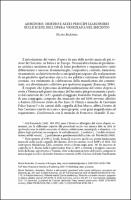Chapter Armidoro, Oristeo e altri principi giardinieri sulle scene dell’opera veneziana nel Seicento
| dc.contributor.author | BADOLATO, Nicola | |
| dc.date.accessioned | 2022-06-01T12:17:26Z | |
| dc.date.available | 2022-06-01T12:17:26Z | |
| dc.date.issued | 2020 | |
| dc.identifier | ONIX_20220601_9788855181501_436 | |
| dc.identifier.issn | 2704-5919 | |
| dc.identifier.uri | https://library.oapen.org/handle/20.500.12657/56253 | |
| dc.description.abstract | The subject of aprince dressing as a gardener to approach his beloved is dear to the European theatrical tradition: the model of Don Duardos by Gil Vicente (1562), reprinted in El rincipe viñador by Luis Vélez de Guevara (1668), is also used in French theatre, which proposes a variation in Le Prince déguisé by Georges de Scudery (1636), partly based on the novel Grisel y Mirabella by Juan de Flores (1524). This subject was later integrated into 17th century Italian theatre, starting with Venetian opera. This essay analyses in particular some works produced in Venice in the middle of the century, starting with Il prencipe giardinieroby Benedetto Ferrari (1644), whose subject anticipates first L’Oristeo (1651) by Giovanni Faustini and Francesco Cavalli, and Laurindo by Gio. Andrea Moniglia, written in 1657 and printed as Il principe giardiniere under the name of Giacinto Andrea Cicognini starting from 1664. | |
| dc.language | Italian | |
| dc.relation.ispartofseries | Studi e saggi | |
| dc.subject.other | Venetian opera | |
| dc.subject.other | prince disguised | |
| dc.subject.other | Ferrari | |
| dc.subject.other | Moniglia | |
| dc.subject.other | intertextuality | |
| dc.title | Chapter Armidoro, Oristeo e altri principi giardinieri sulle scene dell’opera veneziana nel Seicento | |
| dc.type | chapter | |
| oapen.identifier.doi | 10.36253/978-88-5518-150-1.19 | |
| oapen.relation.isPublishedBy | bf65d21a-78e5-4ba2-983a-dbfa90962870 | |
| oapen.relation.isbn | 9788855181501 | |
| oapen.series.number | 209 | |
| oapen.pages | 25 | |
| oapen.place.publication | Florence |

